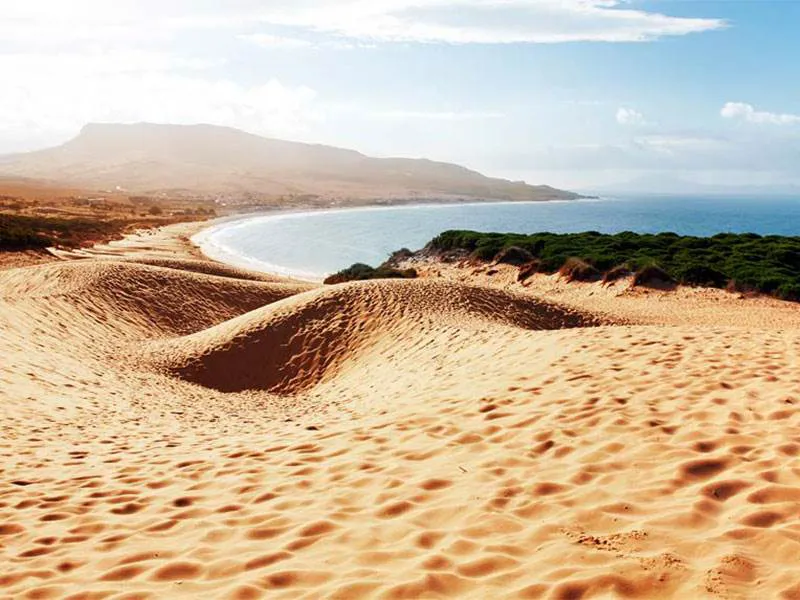Del Estrecho Parque Natural, along the coast of Cadiz province, Andalucia, Spain, preserves the natural habitat of the Gibraltar Strait
By Nick Nutter | Updated 30 Mar 2022 | Cádiz | Birdwatching |
Login to add to YOUR Favourites or Read Later


The Strait
Del Estrecho, the Straits, sometimes called the Gibraltar Strait, only 14 miles wide at the narrowest point, separates two continents, Africa and Europe. It is also the meeting point of an ocean, the Atlantic, and a sea, the Mediterranean. Flora and fauna are conditioned by the proximity to Africa, the deep ocean currents and the prevailing winds that are funnelled by the Strait. It is also the scene of an annual migration of over 250,000 raptors and thousands of passerines and seabirds, one of the most spectacular bird migrations in the world.


The dune at Bolonia
A natural monument, the Bolonia Sand Dune, provides a visual example of the power of the wind. Over 30 metres high this dune is constantly on the move, enveloping the coastal pines as it slowly edges its way inland. The beach at Bolonia is of fine, white, sand whilst the crisp, turquoise, frigid waters of the Atlantic, pound onto the shore in winter, and provide cool relief in the summer. Nearby Tarifa is known as the windy capital.


Cape Trafalgar
Plants such as barley, juniper and the typical shrimp, which gives its name to the lighthouse in the area are adapted to dryness and wind, grow in these coastal sandy areas, Around there are stone pines, coming from the repopulation practiced in the 1960s to contain the dunes, together with a scrub of high ecological value. Moving into the mountains, there are holm oaks, cork oaks and wild olive trees along with repopulated eucalyptus trees. Sea fennels stand out on the cliffs, and daffodils and genistas are everywhere.


Tarifa - windy city
Offshore the constantly turbulent waters have created an underwater garden. Dense meadows of phanerogams and copses formed by red and brown seaweed provide a haven for a huge range of marine fauna some species of which, sponges, jellyfish molluscs and crustaceans are endemic to the Strait. The Strait itself is a migratory route for whales, dolphin, loggerhead turtles, porpoises, tuna and sharks. The tuna migration has been a commercially exploited phenomenon for hundreds of years.


Wind twisted tree at Barbate
Snorkelling, surfing, windsurfing and kitesurfing are all available in this area. For those more interested in dry pursuits there is climbing and walking in the Sierra de San Bartolome and of course birdwatching at numerous sites on the coast.
The Gibraltar Strait is also on a major migration route. Over 300 species of birds including the black stork, black vulture, golden eagle and Montagues harrier make their annual pilgrimage to Africa in the autumn and return in the spring. Their cousins, the Egyptian vulture, griffon vulture and peregrine falcon have made their permanent homes in the rocky outcrops and cliffs of the La Plata and San Bartolome mountains.
February - March
The start of bird of prey migration including Black Kite, Short-toed Eagle & Egyptian Vulture. Cory’s Shearwaters in the straits.
March - April
Black Kite, Egyptian Vulture, Short-toed Eagle, Marsh and Montagu’s Harriers, Buzzard, Booted Eagle and Osprey. Smaller spring migrants include Subalpine & Spectacled Warblers & Black-eared Wheatear and others.
April - May - best period in the spring for watching migratory birds
Migrating passerines and large falls occur in the Strait area after bad weather. Those wanting to observe the greatest variety of species should visit during mid-April to mid-June. At this time birds are still migrating north and most of the summer visitors have arrived to breed. Among the interesting migrants these months include Montagu’s Harrier, Scops Owl, Red-necked Nightjar, Bee-eater, Roller, Hoopoe, Short-toed Lark, Tawny Pipit, Rufous Bush Robin, Northern & Black-eared Wheatears, Rock Thrush, Western Olivaceaous Warbler, Melodious Warbler, Spectacled Warbler, Subalpine Warbler, Orphean Warbler, Willow & Bonelli’s Warblers, Pied Flycatcher, Common Redstart, Woodchat Shrike, Ortolan Bunting and many others.
June - and see above
Honey Buzzard and for other late bird of prey passage involving a lot of non-breeding individuals from species such as Griffon Vulture, Short-toed Eagle, Black Kite.
July - August - the best seabird-watching months
There are large numbers of Balearic and Cory’s Shearwaters offshore and there is a large westward movement of thousands of Audouins’s Gull. Other seabirds likely at this time include Slender-billed Gull, Gull-billed Tern & Black Tern. July to August is also the peak of the southward migration of the White Stork, Black Kite and Common Swift.
August - October
The last week of August and the first ten days of September are the best for large numbers of raptors on migration, especially Honey Buzzard, Egyptian Vulture and Montagu’s Harrier. Black Storks and Short-toed and Booted Eagles follow at the end of September and in early October. The main passerine activity in autumn is in late September to mid-November when large falls occur after bad weather. Finch migration during October and early November is spectacular.
Places such as Punta Carnero, Algarrobo, Punta Camorro and Cazalla watch points, Playa de Los Lances, Sierra de la Plata and Puerto de Facinas are great options. Gibraltar itself is one of the best places to see the bird migration, especially if there is a westerly wind. Make your way to Jew's Gate or even higher. If you like to watch your birds in comfort then the café at the top of the Rock is for you. If the wind is blowing from the west (locally known as a poniente), then the birds tend to be crossing the Strait further east. If the wind is from the east (a levante) then the birds tend to cross further west. During a levante, a cloud often obscures the top of the Rock of Gibraltar making bird watching impossible from there.